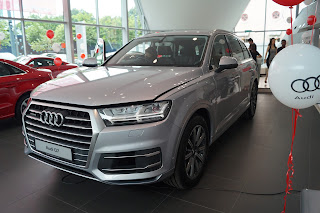Audi Malaysia recently launched the second-generation Audi Q7 ten days ago. Last Saturday, I spent a good time to take a first look of the car at Audi Bukit Bintang, the same place where I took a test drive for the brand new TT. I also make a small comparison between the new Q7 with its previous generation counterpart that has been in the country since 2005.
New Q7 vs Old Q7
The new Q7 was more than a brand new premium SUV in the market. It underpins the current Volkswagen MLB platform, which was also used in the new Bentley Bentayga. This particular SUV is a one-of-a-kind masterpiece that introduced new technologies over other automakers.
The Q7 gets a lot of improvements and touches over the previous generation since the year of 2005. Most importantly is weight reduction (WEIGHT REDUCTION BRO!). Audi claims to trim the fat out of the Q7 by burning 325 kg out of the predecessor.
Like most Audis that came out in the year 2015, the Q7 has a sharper look over the semi-roundish edges. The signature Audi grille is significantly larger to the bottom, also has a sporty front bumper, making it more prestigious over the rugged look like an off-roader. At least is not as crappy as the Lexus RX like the clown face mouth grille.
New to the Q7 is the double arrow-vein like LED headlights, with the Matrix LED ones are optional.
The side profile might trying to fool you by having a shorter length compared the the old car. Wait until you see the rear bootspace.
The rear end design is also sharp, with sleeker LED tail lights.

Next, there is another feature that enables you to fold down the 50:50 split third row rear seat to add more cargo space. The buttons were located at the left edge of the rear or the side of the second row rear seat on either side.
Also, the second row seats have an individual split in contrast to the 60:40 ones found in the previous generation.
Now this is the hot spot, the whole interior experience. The new dashboard strikes on by having a sexy and more elegant with cutting edge design all over it. The old ones are very bulky, but still, timeless. It now has a new MMI touch in front of the gear shifter.
This is the old one.
The Audi Virtual Cockpit is standard across the range. Just like the new TT, it displays beneficial information from the MMI system. In contrast to the TT, the navigation is also standard.
Sorry Drama Band, Audi thought that your song is a world music. Well, there no Gracenote music ID to detect in the car.
When I pressed the View button at the left side of the steering wheel, the virtual dials were expand so I can concentrate how fast I'm driving with clear view of the speedometer. Pressing the button again to shrink the dials so you can concentrate the navigation, song infos and more.
The new MMI has a new technology called Modular Infotainment Matrix (MIB) with Nvidia Tegra 3 processor. Whoa, never seeing a new car with an Nvidia chip, but this is the first time I'm seeing it, after discovering the Intel chip that was used in the new Nissan Skyline (Infiniti Q50 in here). It was meant to speed up the process of the system just like a high-end computer.
Strangely though, when I paired my Lumia 535 to the system, the MMI had a small quirk like being slow and laggy. 15 minutes later, the system was back into normal.
It still uses the same ZF 8 speed automatic like the one you can find in most European cars out there. But when you look closely to the gear shifter itself, its awesome and unique.
The Bose 3D sound system with 19 speakers that produces 558W output is standard. Unless if you an audiophile like me, you can opt for the Bang & Olufsen with 23 speakers which produces 1920W of power. Playing the songs like 'Biarkanlah' by Drama Band and 'SHSM' by Fakhrul Razi via Spotify from my phone, the Bose audio produces a crisp sound and more to clarity. Bass was pretty decent for the audio system itself. This is typical for Bose, just like my V35 that came with the audio system with the same brand.
The main heart is still the same as the old Q7. Powered by a 3.0 TFSI Supercharged V6, and it has been retuned to 333 bhp and 440 Nm of torque. Quattro all-wheel drive system is standard and Audi claims that the acceleration is quicker by 1.6 seconds (6.3 seconds for the new) faster than the previous counterpart (7.9 seconds) in a 0 to 100 km/h sprint. Interestingly, it is nearly as quick as the TT, even though it is 0.3 seconds slower in the same test.
Pricing starts about RM 589,900, a nearly 40k bump price hike out of the previous-gen (RM 550,200) complete with taxes.
Overall, the new Q7 is a game changer for the premium SUV market. Too bad there is no test drive unit right now, and I might wait for it for a month or later to give a full comment about it. Judging from the design, the powertrain engineering and the technologies are slightly enough for me to be impressed with it. Wait until I got lucky to test drive it. Sorry to disappoint you guys.


























Cool site man! Keep up the awesome work!
ReplyDelete